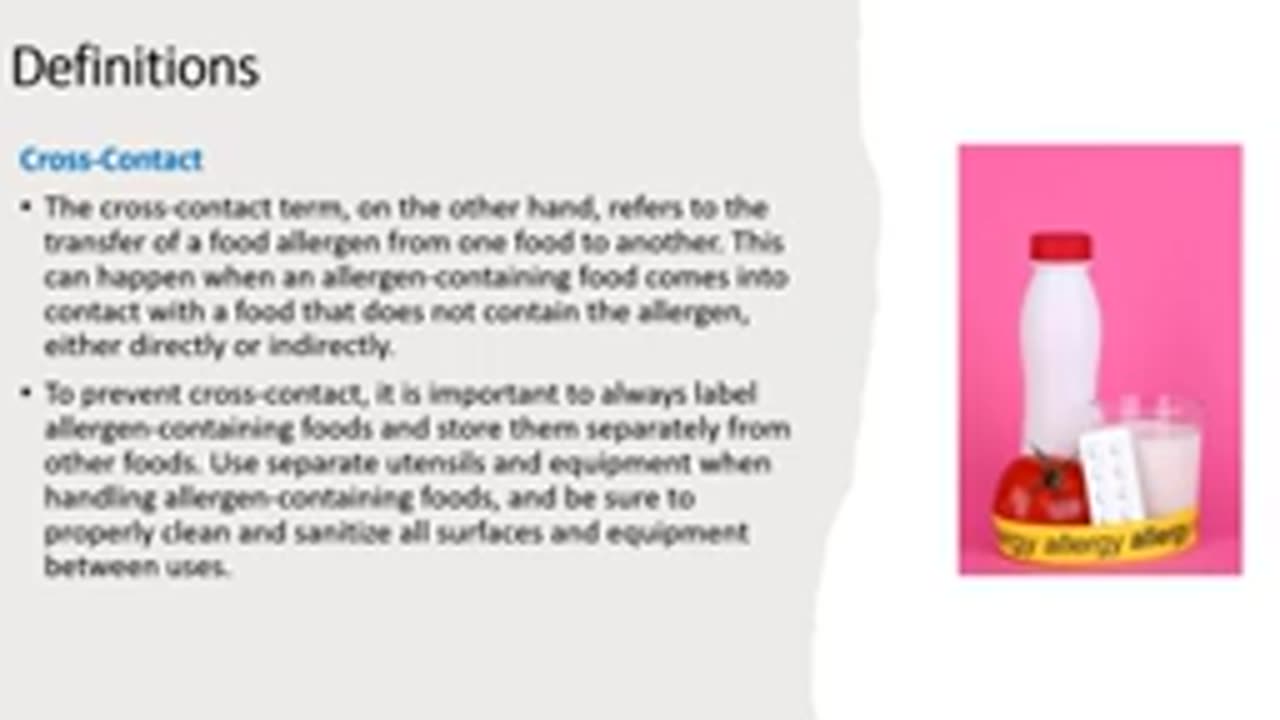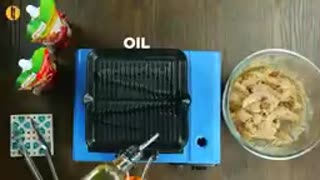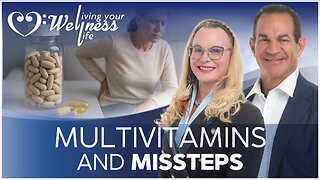Premium Only Content

Cross Contact vs Cross Contamination │ Food Safety
### **Cross Contact vs. Cross Contamination in Food Safety**
In the context of food safety, **cross contact** and **cross contamination** are related but distinct terms, and both pose risks to public health, especially for individuals with food allergies or compromised immune systems. Here’s how they differ:
---
### **1. Cross Contact**
**Definition:**
Cross contact occurs when allergens or substances from one food are transferred to another food, typically through shared utensils, equipment, or surfaces. This is a concern mainly for people with food allergies because even trace amounts of an allergen can trigger severe reactions.
**Key Points:**
- Cross contact refers specifically to allergens or food ingredients mixing unintentionally.
- It can occur even if the food items are not physically touching but come into contact via shared equipment or hands.
- For example, using the same knife to cut a peanut butter sandwich and a non-allergic sandwich could result in cross contact, potentially exposing someone with a peanut allergy to trace amounts of peanuts.
**Examples of Cross Contact:**
- Using the same fryer for both gluten-free and gluten-containing foods, which can transfer gluten.
- Preparing allergen-free food on the same cutting board as food containing allergens without proper cleaning.
- Using the same spoon to stir soup containing dairy and a dairy-free soup.
**Preventing Cross Contact:**
- Use dedicated equipment and utensils for allergen-free foods.
- Implement proper cleaning and sanitizing procedures.
- Clearly label foods to ensure consumers are aware of potential allergens.
- Separate preparation areas for foods with allergens and allergen-free foods.
---
### **2. Cross Contamination**
**Definition:**
Cross contamination occurs when harmful bacteria, viruses, or pathogens from one food or surface are transferred to another food. This typically happens through improper handling, storage, or preparation, and is a major concern for foodborne illnesses.
**Key Points:**
- Cross contamination is related to the transfer of **pathogens**, not just allergens.
- It can happen through direct contact or via indirect means such as contaminated equipment, utensils, or surfaces.
- It is particularly important to prevent cross contamination in raw foods like meat, poultry, and seafood, which may carry harmful microorganisms like Salmonella, E. coli, or Listeria.
**Examples of Cross Contamination:**
- Cutting raw chicken on a cutting board and then using the same board to cut vegetables without cleaning it.
- Storing raw meat on a top shelf in the refrigerator and having its juices drip onto ready-to-eat foods.
- Using a cloth towel that has touched raw meat to wipe down countertops or dishes.
**Preventing Cross Contamination:**
- Separate raw and cooked foods to avoid direct contact.
- Store raw foods (especially meats) at the bottom of the refrigerator to prevent juices from dripping onto other foods.
- Clean and sanitize all utensils, cutting boards, and surfaces between uses.
- Use color-coded cutting boards to differentiate between raw meat and ready-to-eat foods.
- Regularly wash hands and wear gloves when handling food, especially raw items.
---
### **Summary of Differences:**
| Aspect | **Cross Contact** | **Cross Contamination** |
|---------------------|-----------------------------------------------------|-----------------------------------------------------|
| **Definition** | Transfer of allergens between foods or surfaces. | Transfer of pathogens (bacteria, viruses) between foods. |
| **Focus** | Allergens, such as peanuts, dairy, or gluten. | Pathogens like Salmonella, E. coli, or Listeria. |
| **Primary Concern** | Food allergies and sensitivities. | Foodborne illness and safety. |
| **Cause** | Shared equipment, utensils, or surfaces. | Improper handling, storage, or preparation. |
| **Examples** | Peanut butter residue on a knife contaminating a non-peanut sandwich. | Raw chicken juice dripping onto vegetables. |
| **Prevention** | Separate utensils, clean surfaces, label allergens. | Separate raw and cooked foods, sanitize equipment. |
---
### **Why the Distinction Matters**
- **Cross contact** is a concern for **allergen management**. For example, those with food allergies could experience severe reactions if allergens are inadvertently transferred to their food.
- **Cross contamination** is a concern for **food safety and hygiene**. Pathogens from raw food can lead to foodborne illnesses if transferred to ready-to-eat food, often through improper handling or cleaning.
Both require vigilance in food handling, proper training for food handlers, and the implementation of food safety protocols to ensure the safety of consumers, whether they are avoiding allergens or harmful pathogens.
-
 1:35
1:35
HSESafetyInformation
7 months agoMutton Chops two ways- baked & grilled Recipe by Food Fusion (Eid Recipe)
67 -
 11:08
11:08
It’s the Final Round
15 hours ago $2.30 earned💰NFL Week 6 Best Bets🔥Player Prop Picks, Parlays, Predictions FREE Today October 12th
11.3K4 -
 10:28
10:28
nospeedlimitgermany
2 days ago $0.01 earnedMercedes-Benz C 63 AMG *Edition 507* V8 W204 | 507 PS | Top Speed German Autobahn No Speed Limit POV
361 -
 LIVE
LIVE
Reidboyy
1 day ago $0.26 earnedCamo King Grinds 100% Completion for Battlefield 6 *SECRET* Mastery Camo (All Badges + Camos 100%)
70 watching -
 1:03:01
1:03:01
The Heidi St. John Podcast
1 day agoFan Mail Friday: Marriage Q&A — Real Talk From Kona (Part 2)
2.39K -
 LIVE
LIVE
The Pete Santilli Show
2 days ago📺The Pete Santilli Show LIVE Feed 📺 ⚡️ Live Broadcasts Mon-Fri ▶️ 4pm ▶️ 8pm EST
97 watching -
 19:57
19:57
The Bryce Eddy Show
21 hours agoNate Lundquist: Lifewise Academy
1.94K -
 LIVE
LIVE
DynastyXL
3 hours ago👻 DYNASTYXL Presents: “What’s Your Favourite Scary POI?”
25 watching -
 28:31
28:31
Living Your Wellness Life
2 days agoMultivitamins and Missteps
2.16K -
 29:03
29:03
itsSeanDaniel
2 days agoIllegal Migrants REVEAL How They're INVADING Europe 🇪🇺
29.1K24